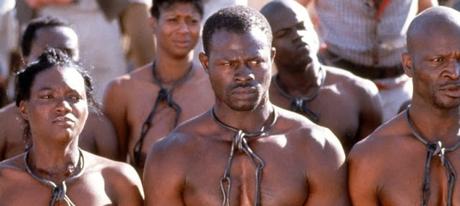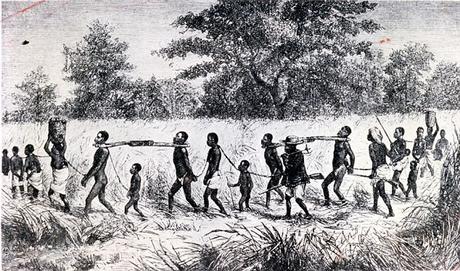 'The
transatlantic slave trade is the largest forced migration in human history and
has no parallel in terms of man's inhumanity to man. This trade in enchained
bodies was a highly successful commercial business for the nations of Europe'.
Their stories make a traumatic reading - slaves laboured mainly in sugar and
coffee plantations and were forced to work around the clock in the fields
during harvest. It is stated that by the
18th century, European traders would sail to the west coast of Africa with
manufactured goods which they exchanged for people captured by African traders.
The European merchants would then cross the Atlantic with ships full of slaves
on the notorious 'Middle Passage'. Conditions were so torrid that many of the
captors, who often had barely any space to move, did not survive the journey.
For those who survived, conditions did not improve much; they were to toil on
plantations across the modern-day United States, the Caribbean and South
American nations such as Brazil, producing crops including sugar, coffee and
tobacco for consumption back in Europe. Happy that the inhuman form was
abolished many decades back !
'The
transatlantic slave trade is the largest forced migration in human history and
has no parallel in terms of man's inhumanity to man. This trade in enchained
bodies was a highly successful commercial business for the nations of Europe'.
Their stories make a traumatic reading - slaves laboured mainly in sugar and
coffee plantations and were forced to work around the clock in the fields
during harvest. It is stated that by the
18th century, European traders would sail to the west coast of Africa with
manufactured goods which they exchanged for people captured by African traders.
The European merchants would then cross the Atlantic with ships full of slaves
on the notorious 'Middle Passage'. Conditions were so torrid that many of the
captors, who often had barely any space to move, did not survive the journey.
For those who survived, conditions did not improve much; they were to toil on
plantations across the modern-day United States, the Caribbean and South
American nations such as Brazil, producing crops including sugar, coffee and
tobacco for consumption back in Europe. Happy that the inhuman form was
abolished many decades back !
 Called
‘Slaving voyage’ – early ones were of John Hawkins is considered to be the
first English slave trader. He left England in 1562 on the first of three
slaving voyages. In 1563 he sold slaves in St Domingo, his second voyage was in
1564 and his final, and disastrous voyage was in 1567. In 1764, a one-hundred
ton brigantine called the Sally embarked from Providence, Rhode Island, to West
Africa on a slaving voyage. The ship was owned by Nicholas Brown and Company, a
Providence merchant firm run by four brothers – Nicholas, John, Joseph, and
Moses Brown. The Sally's voyage was one of roughly a thousand transatlantic
slaving ventures launched by Rhode Islanders in the colonial and early national
period, and one of the deadliest. Of the 196 Africans acquired by the ship's
master, Esek Hopkins, at least 109 perished, some in a failed insurrection,
others by suicide, starvation, and disease.Records of the Sally venture are
preserved in the John Carter Brown Library at Brown University, as well as in
the archives of the Rhode Island Historical Society.
Called
‘Slaving voyage’ – early ones were of John Hawkins is considered to be the
first English slave trader. He left England in 1562 on the first of three
slaving voyages. In 1563 he sold slaves in St Domingo, his second voyage was in
1564 and his final, and disastrous voyage was in 1567. In 1764, a one-hundred
ton brigantine called the Sally embarked from Providence, Rhode Island, to West
Africa on a slaving voyage. The ship was owned by Nicholas Brown and Company, a
Providence merchant firm run by four brothers – Nicholas, John, Joseph, and
Moses Brown. The Sally's voyage was one of roughly a thousand transatlantic
slaving ventures launched by Rhode Islanders in the colonial and early national
period, and one of the deadliest. Of the 196 Africans acquired by the ship's
master, Esek Hopkins, at least 109 perished, some in a failed insurrection,
others by suicide, starvation, and disease.Records of the Sally venture are
preserved in the John Carter Brown Library at Brown University, as well as in
the archives of the Rhode Island Historical Society.
In the second half of the eighteenth century six imperial systems straddled the Atlantic each one sustained by a slave trade. The English, French, Portuguese, Spanish, Dutch, and Danish all operated behind trade barriers (termed mercantilistic restrictions) and produced a range of plantation produce - sugar, rice, indigo, coffee, tobacco, alcohol, and some precious metals - though with sugar usually the most valuable.

It was totally inhumane, of capturing, chaining humans and transporting them herding them into confined space, traded off for commodities and money. There was insurance too; owners had insurable interest on the lives of slaves – yes, Marine Cargo Insurance, as slaves were treated as ‘cargo’- commodity and not humans. A search reveals that in 1856, just five years before the outbreak of the Civil War, the Charter Oak Life Insurance Company printed a pamphlet offering slave owners in six Southern states the option of insuring the lives of their slaves.For just $2, Kentucky, Missouri and Tennessee residents, for example, could purchase a 12-month policy from the Hartford-based insurer on a 10-year-old domestic servant that would yield $100 if the slave died. Policies for older slaves, like a 45-year-old, were more expensive, costing the slave owner $5.50 a year.Though the company no longer exists, these policies are drawing increasing attention nearly 150 years later because of a lawsuit that was filed in United States District Court in Brooklyn, against Aetna Inc. and two other companies, claiming that they profited from the slave trade. It certainly is not pleasant to talk about it today, to put it mildly, but slaves were insured just like any other thing that the farmers owned, that the slave owners owned,;- Whilst slaves were regarded by Jurists of civilized and Christian Europe as mere livestock, it was gravely determined that death self-inflicted under the horror and despair of their condition was a loss arising from the proper vice and inherent pravity of the thing insured, and not chargeable, therefore, to the Underwriters !!! The Courts were even under the pain of listening to solemn arguments in support of the position that loss from throwing overboard part of human cargo of an overloaded slaver, owing to scarcity of water, fell upon the Underwriters as being due to ‘perils of the sea’. His Lordships had to undergo the melancholy degradation of applying all the subtlety of their great intellect in order to assist a special jury of London merchants in coming to the conclusions in a case where ‘mortality by mutiny of slaves’ was included amongst the perils insured against : 1. That all the slaves who were killed in the mutiny, or died of their wounds, were to be paid for. 2. That all those who died of their bruises, which they had received in the mutiny though accompanied by others causes, were to be paid for 3. That all who had swallowed salt water or leaped into the sea and hung upon the sides of the ship without being otherwise bruised, or died of chagrin, were not to be paid for. In those black days of slavery and transhipping humans in most inhumane conditions, policy terms and conditions were clearly drawn and those days it was decided that where slaves died on the passage from scarcity of food caused by the extraordinary and unavoidable delay of the voyage, were considered as natural death, for which Marine Underwriters were not liable. Humiliating as they are to recall these cases so unfavourable to any civilized Nation’s probity that those principles are now applicable only to insurances of livestock. It is another matter in History that these Nations ruled others for centuries trying to educate moral values too, to those under their domain. With regards – S. Sampathkumar 28th Aug 2015.
Bibliography :www.slavevoyages.org; www.cds.library.brown.edu; Arnould on Law of Marine Insurance; NY Times.com…. and more…

